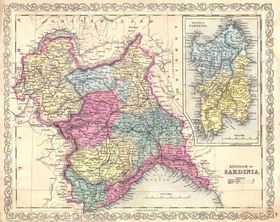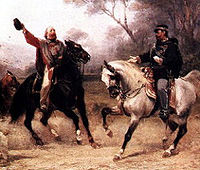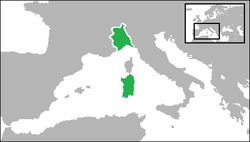Kingdom of Sardinia
|
|||||||||||||||||||||||||||||||||||||||||||||||||||||||||||||
Kingdom of Sardinia, also known as Piedmont-Sardinia or Sardinia-Piedmont, was the name given to the possessions of the House of Savoy in 1723 (or in 1720 according to the international law),[1][2][3][4][5] when the crown of Sardinia was awarded by the Treaty of The Hague to King Victor Amadeus II of Savoy to compensate him for the loss of the crown of Sicily to Austria, retaining in that way the title of king.[2][1] Besides Sardinia, the new kingdom included Savoy, Piedmont, and Nice; Liguria, including Genoa, was added by the Congress of Vienna in 1815. Officially, the nation's name became Kingdom of Sardinia, Cyprus and Jerusalem, the House of Savoy maintaining a national claim to the thrones of Cyprus and Jerusalem, but both had long been under Ottoman rule. During most of the 18th and 19th centuries, the political and economic capital of the kingdom was Turin in Piedmont on the Italian mainland. In 1860, Nice and Savoy were ceded to France as a price paid for French consensus and help to unify Italy. In 1861, the Kingdom of Sardinia became the founding state of the new Kingdom of Italy, annexing all other Italian states. The Kingdom so continued in perfect legal continuity with the actual Italian state, to which it transferred all its institutions.
Contents |
Early history of Piedmont

Piedmont was inhabited in early historic times by Celtic-Ligurian tribes such as the Taurini and the Salassi. They later submitted to the Romans (c. 220 BC), who founded several colonies there including Augusta Taurinorum (Turin) and Eporedia (Ivrea). After the fall of the Western Roman Empire, the region was repeatedly invaded by the Burgundians, the Goths (5th century), Byzantines, Lombards (6th century), Franks (773). In the 9th-10th centuries there were further incursions by the Magyars and Saracens. At the time Piedmont, as part of the Kingdom of Italy within the Holy Roman Empire, was subdivided into several marks and counties.
In 1046, Oddo of Savoy added Piedmont to their main segment of Savoy, with a capital at Chambéry (now in France). Other areas remained independent, such as the powerful communes of Asti and Alessandria and the marquisates of Saluzzo and Montferrat. The County of Savoy was elevated to a duke in 1416, and Duke Emanuele Filiberto moved the seat to Turin in 1563. When Spain tried to reconquer Sicily, it was granted to Austria. To compensate Piedmont, the duke received Sardinia and was able to keep the title of king he had from Sicily. In 1720, the Duke of Savoy became King of Sardinia, founding what evolved into the Kingdom of Sardinia or Sardinia-Piedmont and increasing Turin's importance as a European capital.
Early history of Sardinia

In 1297, Pope Boniface VIII, intervening between the Houses of Anjou and Aragon, established on paper a regnum Sardiniae et Corsicae that would be a fief of the Papacy. Then the Pope offered his newly-invented fief to James II of Aragon, promising him papal support should he wish to conquer Pisan Sardinia in exchange for Sicily. In 1323 James II formed an alliance with Hugh II of Arborea and, following a military campaign which lasted a year or so, occupied the Pisan territories of Cagliari and Gallura along with the city of Sassari, claiming the territory as the Kingdom of Sardinia and Corsica. In 1353 Aragon made war on Arborea, then fought with its leader Marianus IV of Arborea,of the Cappai de Bas family, but did not reduce the last of the autochthonous giudicati (indigenous kingdoms of Sardinia) until 1410. The Kingdom of Sardinia and Corsica retained its separate character as part of the Crown of Aragon and was not merely incorporated into the Kingdom of Aragon. At the time of his struggles with Arborea, Peter IV of Aragon granted an autonomous legislature to the Kingdom, which had one of Europe's most advanced legal traditions. The Kingdom was governed in the king's name by a viceroy. When in 1409, Martin the younger, king of Sicily and heir to Aragon, defeated the last Sardinian giudicato but then died in Cagliari of malaria, without issue, Sardinia passed with the Crown of Aragon to a united Spain. Corsica, which had never been conquered, was dropped from the formal title. The loss of the autochthonous' independence, the firm Aragonese (later Spanish) rule, with the introduction of a sterile feudalism, as well as the discovery of the Americas, provoked an unstoppable decline of Kingdom of Sardinia. A short period of resurgence occurred under the local noble Leonardo de Alagon, marquess of Oristano, who managed to defeat the viceroy's army in the 1470s but was later crushed at the Battle of Macomer (1478), ending any further hope of independence for the island. The unceasing attacks from North African pirates and a series of plagues (from 1582, 1652 and 1655) further worsened the situation.
The London's changeover

The Spanish domination of Sardinia ended at the beginning of the 18th century, as a result of War of the Spanish succession. By the Treaty of Utrecht of 1713, Spain's European empire was divided: Savoy received Sicily and parts of the Duchy of Milan, while Charles VI (the Holy Roman Emperor and Archduke of Austria), received the Spanish Netherlands, the Kingdom of Naples, Sardinia, and the bulk of the Duchy of Milan. In 1718, by the Treaty of London among the great powers, Victor Amadeus II, duke of Savoy and sovereign of Piedmont, was forced to yield Sicily to the Austrian Habsburgs and in exchange received Sardinia. Two years later, on Aug. 24, 1720, he formally took possession of the island.
Napoleonic Wars and the Congress of Vienna

In 1792 Piedmont-Sardinia joined the First Coalition against the French First Republic, but was beaten in 1796 by Napoleon and forced to conclude the disadvantageous Treaty of Paris (1796), giving the French army free passage through Piedmont. On December 6, 1798 Joubert occupied Turin and forced Charles Emmanuel IV to abdicate and leave for the island of Sardinia. The provisionary government voted to unite Piedmont with France. In 1799 the Austro-Russians briefly occupied the city, but with the Battle of Marengo (1800), the French regained control. The island of Sardinia stayed out of the reach of the French for the rest of the war.
In 1814 the kingdom was restored and enlarged with the addition of the former Republic of Genoa, now a duchy, and it served as a buffer state against France. This was confirmed by the Congress of Vienna. In the reaction after Napoleon, the country was ruled by conservative monarchs: Victor Emmanuel I (1802–21), Charles Felix (1821–31) and Charles Albert (1831–49), who fought at the head of a contingent of his own troops at the Battle of Trocadero, which set the reactionary Ferdinand VII on the Spanish throne. Victor Emanuel I disbanded the entire Code Napoléon and returned the lands and power to the nobility and the Church. This reactionary policy went as far as discouraging the use of roads built by the French. These changes typified Piedmont. The Kingdom of Sardinia industrialized from 1830 onward. A constitution, the Statuto Albertino, was enacted in the year of revolutions, 1848, under liberal pressure, and under the same pressure Charles Albert declared war on Austria. After initial success the war took a turn for the worse and Charles Albert was defeated by Marshal Radetzky at Custozza.
Italian unification


Like all of Italy, the Kingdom of Sardinia was troubled with political instability, under alternating governments. After a very short and disastrous reneal of the war with Austria in 1849, Charles Albert abdicated on March 23, 1849, in favour of his son Victor Emmanuel II.
In 1852 a liberal ministry under Count Camillo Benso di Cavour was installed, and the Kingdom of Sardinia became the engine driving the Italian Unification. The Kingdom of Sardinia (Piedmont) took part in the Crimean War, allied with the Ottoman Empire, Britain, and France, and fighting against Russia.
In 1859 France sided with the Kingdom of Sardinia in a war against Austria, the Austro-Sardinian War. Napoleon III didn't keep his promises to Cavour to fight until all of the Kingdom of Lombardy-Venetia had been conquered. Following the bloody battles of Magenta and Solferino, both French victories, Napoleon thought the war too costly to continue and made a separate peace behind Cavour's back in which only Lombardy would be ceded. Due to the Austrian government's refusal to cede any lands to the Kingdom of Sardinia, they agreed to cede Lombardy to Napoleon who in turn then ceded the territory to the Kingdom of Sardinia to avoid 'embarrassing' the defeated Austrians. Cavour angrily resigned from office when it became clear that Victor Emmanuel would accept the deal.
Garibaldi and the Thousand
On March 5, 1860 Parma, Tuscany, Modena, and Romagna voted in referendums to join the Kingdom of Sardinia. This alarmed Napoleon who feared a strong Savoyard state on his southeastern border and he insisted that if the Kingdom of Sardinia were to keep the new acquisitions they would have to cede Savoy and Nice to France. This was done after dubious referendums showed over 99.5% majorities in both areas in favour of joining France.
In 1860 Giuseppe Garibaldi started his campaign to conquer southern Italy in the name of the Kingdom of Sardinia. He quickly toppled the Kingdom of the Two Sicilies and marched to Gaeta. Cavour was actually the most satisfied with the unification while Garibaldi wanted to conquer Rome. Garibaldi was too revolutionary for the king and his prime minister.
Towards Kingdom of Italy
On March 17, 1861 the Kingdom of Italy was proclaimed by the Parliament, so ratifying the annexations of all other Italian states to Piedmont. The institutions and laws of the Kingdom were quickly extended to all Italy, brutally abolishing the administrations of the other regions. Piedmont would become the most dominant and wealthiest region in Italy and the capital of Piedmont, Turin, would remain the Italian capital until 1865 when the capital was moved to Florence; but in contrast, many revolts exploded through the peninsula, especially in Southern Italy. The House of Savoy would rule Italy until 1946 when Italy was declared a republic.
Flags
When the Duchy of Savoy changed its name into Kingdom of Sicily in 1713 and Kingdom of Sardinia in 1723, it maintained its traditional flag depicting a white cross on a red field. But a problem arose: if the Duchy owned the small harbour of Nice only, the union with Sicily and then Sardinia gave to the Kingdom a quite big fleet, which had the same flag of Malta. To disambiguate the ships of the two different States, the House of Savoy added a blue border to its flag, and then it reduced the cross in a single quarter.
The flag had following minor changes until 1848, when a revolution happened: to follow the liberal revolutions which were exploding in all Europe, King Charles Albert adopted the Napoleonic Italian tricolour, surmonted by the Savoyard shield, as national flag. This flag became the flag of Italy until 1946.
 First original flag |
 Second revised flag |
 Third blue flag |
.svg.png) Final tricolour flag |
Constituent countries
Until the perfect fusion of 1848, the Savoyard State was formed by different constituent countries:
- The Duchy of Savoy
- The Principality of Piedmont
- The County of Nice
- The Duchy of Genoa
- The Viceroyalty of Sardinia
References
- ↑ 1.0 1.1 "Sardinia, kingdom of". The Columbia Electronic Encyclopedia (6 ed.). Columbia University Press. 2007. http://www.infoplease.com/ce6/history/A0843673.html#axzz0yhEdFv00.
- ↑ 2.0 2.1 "Sardinia (historical kingdom, Italy)". Encyclopædia Britannica. http://www.britannica.com/EBchecked/topic/524132/Sardinia. Retrieved 6 September 2010.
- ↑ Benigni, Umberto (1912). "Sardinia". The Catholic Encyclopedia. 13. New York: Robert Appleton Company. http://www.newadvent.org/cathen/13473b.htm. Retrieved 6 September 2010.
- ↑ Thuesen, 2002, p. 506.
- ↑ The Savoyard State continued to be styled as Kingdom of Sicily, Jerusalem and Cyprus on official acts until 1723, when the king ended his protests against the forced changeover between Sicily and Sardinia.
Sources
- Hearder, Harry (1986). Italy in the Age of the Risorgimento, 1790-1870. London: Longman. ISBN 0582491460.
- Martin, George Whitney (1969). The Red Shirt and the Cross of Savoy. New York: Dodd, Mead and Co.. ISBN 0396059082.
- Storrs, Christopher (1999). War, Diplomacy and the Rise of Savoy, 1690-1720. Cambridge University Press. ISBN 0521551463.
- Thuesen, Nils Petter (2002). Verdens historie i årstall. Orion. ISBN 9788245805178.

